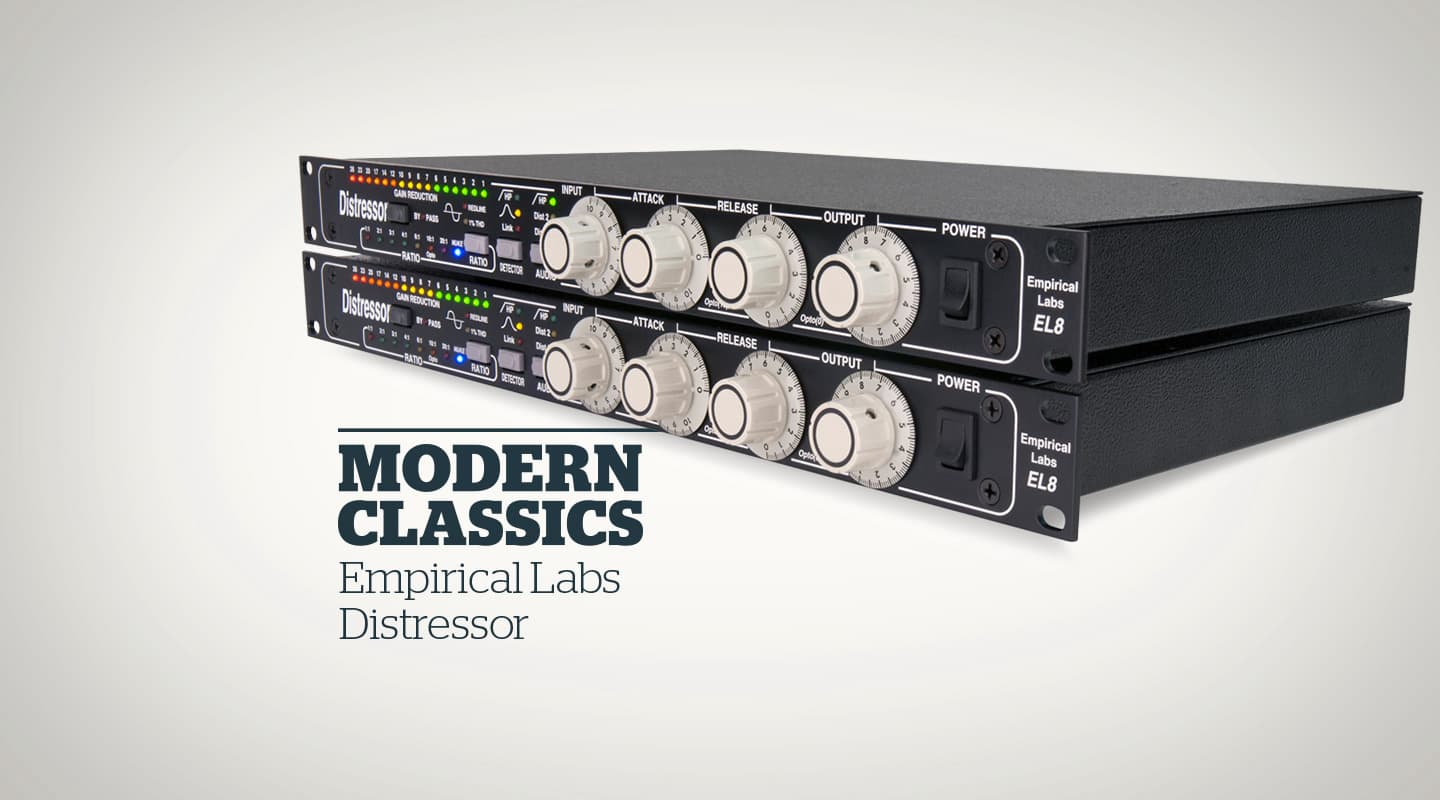
Modern Classics: Empirical Labs Distressor
It’s a miracle that one small box could house so much vintage colour. Dave Derr explains exactly how he developed so much character.
Dave Derr knows he’s one lucky son of a gun. Spoilt even, he reckons. He’s gone from a bandanna-wearing guitarist, to moving his business, Empirical Labs, to a bigger part of the building because its ‘packed to the gills’ with stock.
His talisman… his rabbit’s foot, is the Distressor. A compressor that manages to capture the essence of multiple classics in a single-rack space without feeling like any specific one. Rather than getting bogged down by a component-for-component remake, or pulling a 90-year old out of bed so the original hands can wind some extinct transformer as only they know how, it’s Derr’s interpretation of these classics that really gives the box its own unmistakable character. And in so doing, he’s built a classic of his own.
FLOWING WITH THE TIDE
Like most designers, Derr’s engineering career took off as his music career was taking a dive. Derr’s first ‘real’ job was at Eventide, right at its height of popularity. In fact, the second unit he ever worked on was the H3000 UltraHarmonizer, a classic in its own right. “It was 1984, and my band broke up,” begins Derr. “I didn’t know what I was going to do. I could tune pianos, so I tuned pianos. I ended up running into a guy at a Radio Shack and that led to a job at a medical electronics company where I learned to use scopes. Then I saw an opening at Eventide. We didn’t have email then, so I sent a letter out. Anyway, they asked me in for an interview and I got the job.
“It was very lucky, because they gave a written test and I’m a terrible test taker — never did good in school. But it was like someone made the test for me. I happened to know just about everything on it even though I didn’t have a degree.
“The first project I worked on was a delay for broadcast so they could bleep out the curse words, then the H3000 and the DSP4000. I designed the analogue section and a lot of presets, not the algorithms. It really opened my eyes. I worked with great engineers like Bob Belcher and Ken B (Bogdanowicz, both now at SoundToys) and they really schooled me. I was really blessed to even get that job.”
While Derr was working at Eventide, he was also running his own studio. Eventually the studio started paying the bills, and the roundabout swung full circle… he was back making music full-time again. He was able to leave Eventide, which was bittersweet, but working in the studio only drew him closer to compressors and back to designing gear. “I got two or three pieces of gear that really changed the sound,” said Derr. “Usually you say it’s not the paintbrush, it’s the painter. But if you just have a leaf to paint with, you’re not going to get very good.”
The pieces that really affected him were his UREI 1176, Teletronix LA2A and Valley People Gain Brain. “Especially the 1176,” said Derr. “I had a very small space, and the 1176 took me from really, really bad drum sounds to useable ones. I was lucky because an engineer came down from Chicago to work at the studio (who ended up being Phil Ramone’s engineer) and he taught me how to use the 1176 and the parametric EQs.”


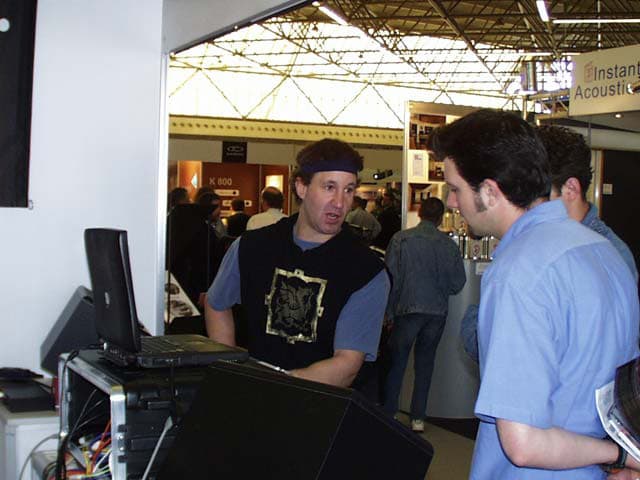
Usually you say it’s not the paintbrush, it’s the painter. But if you just have a leaf to paint with, you’re not going to get very good
DEVELOPING CHARACTER
It was 1992 when Derr left Eventide, and at the time Universal Audio wasn’t producing anything; so you couldn’t get new 1176s or LA2As, and you also couldn’t just grab a schematic off the internet. Derr had to reverse engineer the classics to build something new. “I liked the sound of these older boxes and all the new compressors I had, not one even came close,” said Derr. “They had no character at all.”
It was this combination of training in modern production, and a love for vintage character that made the Distressor what it is. The basic idea was to divide the design up into the important non-linear characteristics that gave the original units their sound, and surround it with modern, reliable, linear components and designs.
The approach made a few decisions for him. Pots and switches, which undoubtedly get flaky, were replaced with military-grade, gas-sealed relays that have never failed, and glowing VU meters switched out for LED bar graphs. “Even though VU meters are warm and fuzzy,” said Derr. “Testing them, especially the LA2A, revealed how slow they really are. It would be registering 6dB of compression on the meter but I knew it was a lot more. And when I measured it with analysers, it would be 20 or 30dB!”
He did take some inspiration from period aesthetics though: “The old boxes had big knobs, which allowed you to take chalk pencils or little pieces of tape to mark your settings. And a two-inch knob lets you get pretty darn precise. So that was on my list too… big knobs. I like big writing too because in the studio it’s often dark. Older gear had larger writing because they couldn’t silk screen back then. But I didn’t really consciously try to make it look retro. The thing is pretty ugly actually.”

FEEDBACK FROM THE MASTERS
When Derr was researching compressors to see how they operated and their effect on music program, he naturally went after the classics. The 1176 was first on the chopping block, then he managed to get stuck into a Fairchild 670, which he later found out was pretty far out of calibration. The Distressor 10:1 setting is inspired by opto compressor circuits like the LA2A, which presented another problem in itself. “I had two LA2As, and they were pretty different from one another,” recalled Derr. “I picked the one I thought was probably most typical, but the fact is, there’s not a typical LA2A. I’ve since bought two more, and they are really different again. Though, interestingly, it’s mostly only evident looking at the test equipment, it’s amazing what your ear doesn’t hear.
“For instance one of the LA2As is very program-dependent, like, overnight dependent. If you had it on a lead vocal, played the song through, then rewound and start it right over, you would get one sound. If you sat for five minutes and then started over, you’d get a different sound, because it has this incredibly long time decay. One of my newer LA2As doesn’t have that, the program-dependent time element is almost non-existent.
“The one I modelled, it would differ even if you left it overnight. If you do a tone burst 20 seconds apart, and then do a tone burst the next day, it’s not even close. But I only made it 30 or 40 seconds in mine, not the overnight setting.”
While not direct copies of the circuits by a long shot, he did base the design on one important characteristic common to all his favourite compressors. “I knew the sound I wanted, and it was always from a feedback compression design,” said Derr. “Feedback compression is where you take the output of the control element, the VCA, and control the gain. Whereas feed-forward compression takes the input. Before UREI quit making gear, it put out this box called the 7110 [when JBL owned the name]. It was a compressor, single height, meant to be the latest generation 1176. I bought one and it was horrible! Honestly, I couldn’t find anything it sounded good on. It was a feed-forward compressor, not a feedback.”
FETTLING WITH CIRCUITS
But with an approach in mind, it still didn’t account for how Derr would achieve it. Even in his straw poll of favourite compressors, there were at least four or five ways of implementing the feedback principle. “It’s probably not a secret any more,” said Derr. “I use FETs to get most of the colouration. FETs act like tubes in the triode range. If you work within a certain range of level and current, it’s almost identical to how tubes clip. The Gain Brain, 1176 and LA2A all had that colour in them. While the LA2A actually had tubes, the Gain Brain and 1176 had FETs. Knowing I loved that sound, that’s what I started with: FET-based control.
“The cool thing was, once I started looking at the rest of the circuitry, it could be done a million different ways. That little non-linear sonic element in the middle is what I adjust and fiddle with to get the sounds and distortion modes. Everything else on either side of it is linear, and it’s easy to add a high-pass filter or band-pass emphasis in the detector using modern ICs, which you couldn’t do in the old days.
“Then I was able to look at what else I could do, and one of the easiest things was distortion and saturation. All I had to do was manipulate operating levels. The harder I hit the non-linear circuit, the more crunchy it got. It’s not really a distortion box, but you can hear distortion sometimes, depending on the setting.
“I probably could have rolled off some more higher frequencies. The 1176 really starts to roll off before 20kHz, with the Distressor, it’s 200kHz, which is like lifting the veil. Sweep it, and it’s within a fraction of a dB between 20Hz and 20kHz — stable, super linear and clear. It goes way up because we don’t have any transformers in it. Once you put in a transformer, especially in the old days, getting more than 20kHz and down to 20Hz is tough. When you roll off at 20kHz you start to get some phase issues in the hearing range. It’s not much, but by going up to 200kHz, there’s no phase weirdness at all. One day we may add transformers back in, like we have on some other products, because they do things you can’t achieve any other way.”

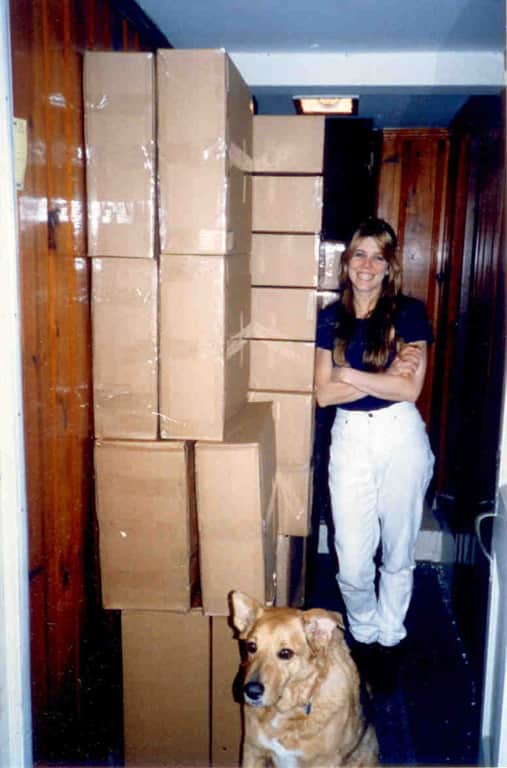

DOWN IN JERSEY
These days, Empirical Labs employs 10 people. It’s a fairly lean operation aided by the modern-meets-vintage philosophy of the Distressor. You need less hands if you eschew mid-century production methods in favour of robotic PCB board assembly. And keeping things local is easy in New Jersey. There are 10 circuit board assemblers within 15 miles of ELI’s door.
Derr takes reliability extremely seriously, so seriously, in fact, the tech support email goes directly to Dave. He can afford to do that, because reliability is designed into Empirical Labs products. “People think our equipment is great value anyway,” said Derr. “But to give great customer service we actually price it a little above where we could if we were trying to be cutthroat. We build in the cost of us supporting that piece of gear, so we try to make it as reliable as possible. That’s why we eliminated transformers, there’s no connectors inside the unit, all those things are a liability. Some of the early pots we used were carbon-film, which started to get crackly after several years, so we went to conductive plastic.”
But it hasn’t become any easier. Stricter manufacturing standards which banned the use of lead solder, really hurt the quality across the industry. “RoHS [Restriction of Hazardous Substances] laws killed us,” said Derr. “They’re still killing us. Our office people didn’t want to lie and say we were RoHS compliant when we weren’t (which some people do), so we started using lead-free parts, which are not as reliable. They’re getting there, but we even had transistors fail! Because I take reliability so seriously, those first couple of years of RoHS really hurt me and cost us hundreds of thousands of dollars.
“It’s getting harder to source parts, because they’re phasing out all these components. We started using microprocessors to get rid of discrete logic because even discrete logic chips which have been around for 50 years are going away. We’ve been so lucky to have cash flow because our first products made money, so when we buy transistors, we’ll buy them by the tens of thousands.”
DISTRESSED SALES
Getting to that point is rare for an audio manufacturer, especially when building a business around a product that had ‘boutique’ written all over it. But even though it took a few years to get the Distressor, and Empirical Labs, off the ground, Derr still considers himself lucky it happened at all. It’s a miracle getting working audio engineers to take a new compressor out of its box, let alone believe in it enough to add it to their workaday routine. Especially when they’re already loaded up with classics like the 1176, LA2A, and even Fairchilds. “It’s very hard,” recalls Derr. “You send out the first few units without expecting to get paid for it. I had been in the business at Eventide so we had a few people, most notably George Massenburg, who I’d met in the mid-’70s, grab onto the Distressor. We sold almost nothing in New York until Michael Brauer came by three or four years after making it. Some units even came back unopened! I sent a unit to Bob Clearmountain and he never even opened it. Now he has six of them!
“The other person was Fletcher from Mercenary Audio. He only sold old gear because he didn’t like a lot of new stuff. I’d met him at Eventide and sent him a Distressor. I didn’t tell him anything about it, except that it was new and to have a play with it. He ended up dragging me to my first AES, which was instrumental.
“In the early days, I thought it would be right up the alley of engineers in the UK, because it’s coloured and you can do crazy stuff with it. I sent it to the biggest distributor over there, and it just sat on a guy’s desk. Finally we signed with Unity Audio, and Kevin Walker went and got it, slung it on his motorcycle and started spruiking at studios around the UK. Within weeks we had sales going.
“In the first year we probably got paid for three or four. The next year we sold 100, and it was exponential after that. We’re going on 26,000 now.
“A lot of people, they design two or three products and maybe the fourth one will take off. We were very lucky our first product caught on because it made it so easy for me to develop more.” Lucky, indeed.

Aviom A-16 Personal Mixer

Released: 2002
Price: $1295
Providing individual monitor mixes for performers, especially in the recording studio, had long been a problem looking for an elegant solution. In the old analogue world it could only be achieved by having lots of aux sends, cabling and headphone amps… and a patient engineer to drive all those mixes. It worked if you were in a decent studio that had the equipment and the time to set it up, otherwise it was a case of “everyone hears the same thing”. Then along came the Aviom A-16 Personal Monitor Mixing System. A product of the digital age it allows multi-channel audio to be converted to 24-bit digital, and sent via Cat5 to individual 16-channel mixing stations. Once the system is connected, the engineer can concentrate on the recording channels and hopefully won’t hear the words “I can’t hear myself”. The performers love it. In the original AT review Trevor Cronin gave it credit for “empowering the performer” and I can only agree. Controlling what they hear increases the performer’s engagement in the session, provides comfort to nervous musicians, and leads to more assertive performances.
In a live context the A-16 has tracked the popularity of in-ear monitoring. Aviom hasn’t taken over the rock ’n’ roll stage but has transformed pit orchestra/show band foldback along with church stages and the like.
Australia’s most popular monitor engineer Rod Matheson has an Aviom system and I asked him what changes it had made to his job, he smiled and replied: “well it means they can do it themselves”. Rod saw no threat to his own gig and always found the Aviom to be reliable and easy to use. A downside? Rod noticed that while the Aviom’s A-Net latency was perfectly acceptable in isolation, when combined with certain digital consoles (with their own latency) the total delay was sometimes enough to be noticeable by vocalists using IEMs.
The Aviom A-16 looks at home on a stage and gives performers the ability to not only set their own mix and volume, but to be able to change it through the show. Again, it’s about control and confidence leading to a better performance.
HOW IT CHANGED THE GAME: DIGITAL TRANSPORT
If a measure of a product’s innovation is how long it takes for the competition to catch up and indeed how many copy-cats there eventually are, then Aviom’s A-16 is legendary. Ultimately, despite the neat user interface, the real smarts lay in the multi-channel digital signal transport, which proved to be the biggest barrier to entry. A-Net was years ahead — low latency and high quality.
Around 12 years after the release of the original, the Aviom A360 personal mixer has been released. That said, the original form factor of the A-16II remains.
These days, of course, pretty much every digital mixer lets performers control their aux send from a smartphone or tablet app. Which is not as refined as laying out a separate system like Aviom. But if you were to trace back to a moment we figured ceding control of monitor mixes to musicians was a good idea, you’d be staring at a small blue device. — Mark Woods

Line 6 POD

Released: 1998
Price: $999
The Line 6 POD guitar amp modeller changed the way musicians and engineers looked at pulling guitar sounds. The idea of being able to re-create the sounds of all the classic amps was enormously appealing and was immediately embraced as the answer to many a guitarist’s dreams — right from the start guitarists liked the sounds and feel of playing through the POD.
Bright red and kidney shaped with an LED screen in the middle surrounded by 10 control knobs, compared to the stomp boxes and guitar multi-FX units of the time, the POD looked like something from the future. Selecting sounds by choosing an amp model, tweaking it and adding effects was intuitive and rewarding. The switchable speaker-sound simulator made it more realistic for recording.
For live shows, convenience goes a long way and lugging an esoteric guitar amp around has always been inconvenient and risky. The POD could be plugged directly into the PA and heard through the monitor system so the amp could stay at home. If an amp was used on stage it didn’t have to be cranked to get the right tone and the POD’s 32 user memories ensured consistent sounds that saved time at soundchecks.
The Line 6 POD was a natural in the studio — minimising the time it took to pull a sound and opening up a world of tone many studios simply didn’t have in their sonic arsenal. In its initial Issue 6 review AT’s Trevor Cronin suggested every studio should have one so they would always have good guitar sounds at hand. If bands brought their own POD to the studio the getting-a-guitar-sound problem went away and everyone could focus on their performance. The POD spawned the re-amping phenomenon, where you record clean and play the take back into the POD for infinite tweaking. At home with a pair of headphones the POD allowed you to rehearse as if you had an amp screaming — roaring guitars in a suburban bedroom.
HOW IT CHANGED THE GAME: INSTANT GRATIFICATION
The POD gave the world its first practical glimpse at how physical modelling can change the world. Prior to the POD, modelling was mostly the preserve of keyboards, with Nord, Yamaha and the like more accurately recreating arcane synths you couldn’t afford, or wind instruments that didn’t ever genuinely replace anything. Did the POD precisely emulate some of the most coveted guitar amps of history? Who cares. It was close enough. Even close enough for many of the pros who owned the amps to opt for the convenience, the flexibility and the reproducibility of the Line6 POD. — Mark Woods



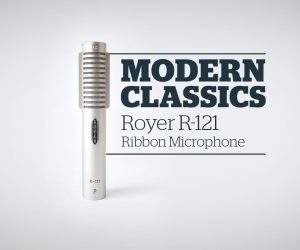


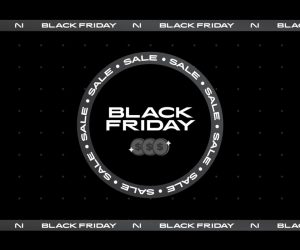










Amazing insight, thanks!